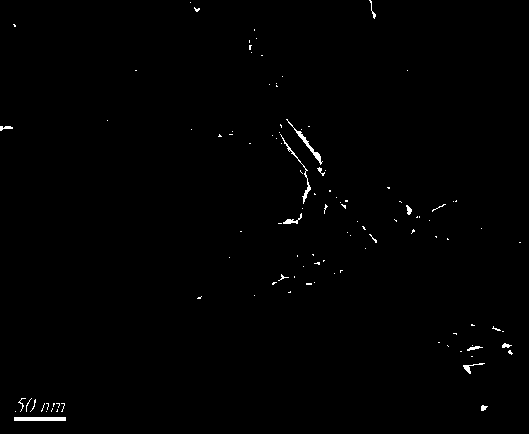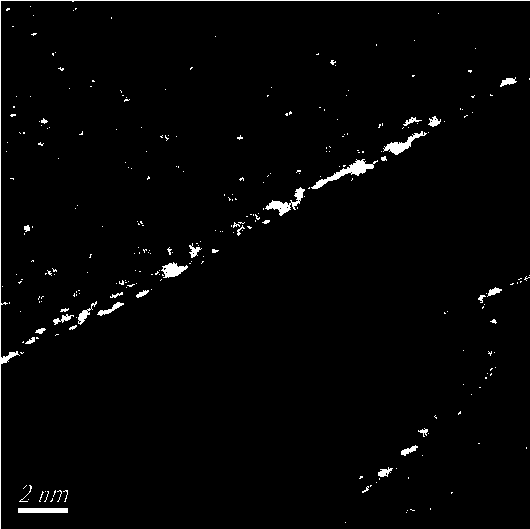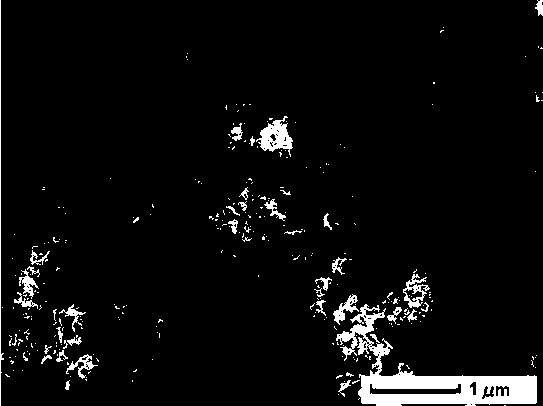Method for preparing nanometer composite with chrysanthemum structure
A nano-composite material, chrysanthemum technology, applied in chemical instruments and methods, textile industry wastewater treatment, titanium oxide/hydroxide, etc., can solve the problems of poor photocatalytic effect and high cost of functional materials, and achieve low energy consumption and preparation The process is simple and easy, and the effect of visible light absorption effect is good
- Summary
- Abstract
- Description
- Claims
- Application Information
AI Technical Summary
Problems solved by technology
Method used
Image
Examples
Embodiment 1
[0028] Add 15 mg of titanium dioxide nanosheets into 60 ml of deionized water and ultrasonically disperse to obtain a titanium dioxide dispersion; under magnetic stirring conditions, add 90 mg of sodium molybdate and 180 mg of thioacetamide to the above titanium dioxide dispersion to obtain a mixed solution A; After the dropwise addition, the mixed solution continued to stir for 30 minutes and then transferred to a polytetrafluoroethylene inner container, and the inner container was sealed in a stainless steel hydrothermal reaction kettle, and reacted for 20 h at 200 ° C. After the reaction, the reaction kettle Naturally cooled to room temperature, the obtained product was separated by centrifugation, washed with deionized water and absolute ethanol, and dried in vacuum.
Embodiment 2
[0030] Add 10 mg of titanium dioxide nanosheets into 60 ml of deionized water, and ultrasonically disperse to obtain a titanium dioxide dispersion; under magnetic stirring conditions, add 90 mg of sodium molybdate and 180 mg of thioacetamide to the above titanium dioxide dispersion to obtain a mixed solution A; After the dropwise addition, the mixed solution continued to stir for 30 minutes and then transferred to a polytetrafluoroethylene inner container, and the inner container was sealed in a stainless steel hydrothermal reaction kettle, and reacted for 20 h at 200 ° C. After the reaction, the reaction kettle Naturally cooled to room temperature, the obtained product was separated by centrifugation, washed with deionized water and absolute ethanol, and dried in vacuum.
Embodiment 3
[0032] Add 15 mg of titanium dioxide nanosheets into 60 ml of deionized water and ultrasonically disperse to obtain a titanium dioxide dispersion. Under magnetic stirring conditions, 90 mg of sodium molybdate and 180 mg of thioacetamide were added to the above titanium dioxide dispersion to obtain a mixed solution A. After the dropwise addition, the mixed solution continued to stir for 30 minutes and then transferred to a polytetrafluoroethylene liner, and the liner was sealed in a stainless steel hydrothermal reactor, and reacted for 24 h at 180 ° C. After the reaction, the reactor was naturally cooled After reaching room temperature, the obtained product was separated by centrifugation, washed with deionized water and absolute ethanol, and dried in vacuum.
PUM
| Property | Measurement | Unit |
|---|---|---|
| concentration | aaaaa | aaaaa |
| size | aaaaa | aaaaa |
| thickness | aaaaa | aaaaa |
Abstract
Description
Claims
Application Information
 Login to View More
Login to View More - R&D
- Intellectual Property
- Life Sciences
- Materials
- Tech Scout
- Unparalleled Data Quality
- Higher Quality Content
- 60% Fewer Hallucinations
Browse by: Latest US Patents, China's latest patents, Technical Efficacy Thesaurus, Application Domain, Technology Topic, Popular Technical Reports.
© 2025 PatSnap. All rights reserved.Legal|Privacy policy|Modern Slavery Act Transparency Statement|Sitemap|About US| Contact US: help@patsnap.com



